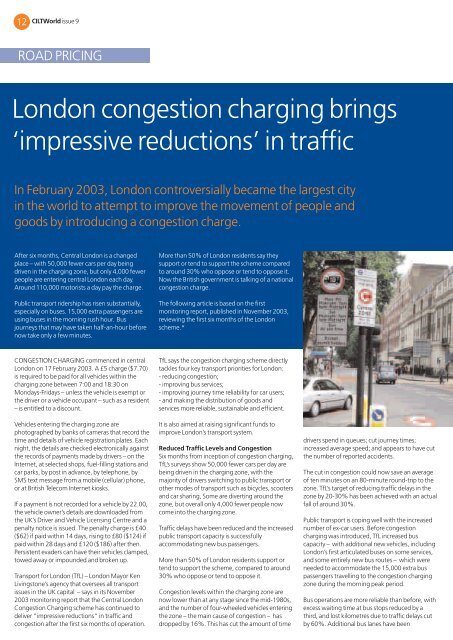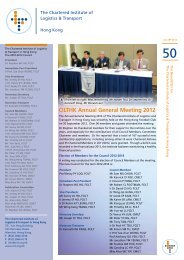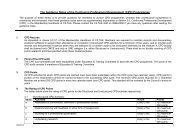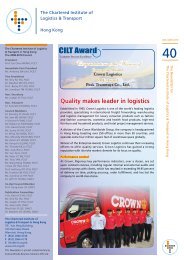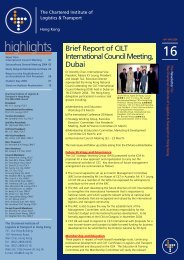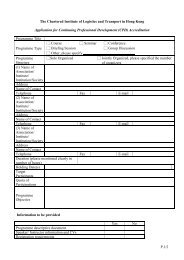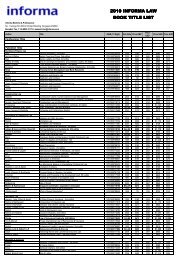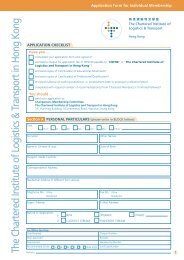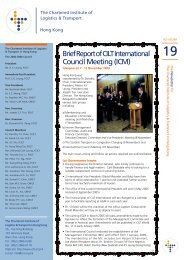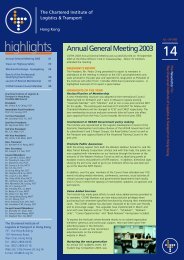CIT WORLD 8 TEMPLATE - The Chartered Institute of Logistics and ...
CIT WORLD 8 TEMPLATE - The Chartered Institute of Logistics and ...
CIT WORLD 8 TEMPLATE - The Chartered Institute of Logistics and ...
You also want an ePaper? Increase the reach of your titles
YUMPU automatically turns print PDFs into web optimized ePapers that Google loves.
12<br />
CILTWorld issue 9<br />
ROAD PRICING<br />
London congestion charging brings<br />
‘impressive reductions’ in traffic<br />
In February 2003, London controversially became the largest city<br />
in the world to attempt to improve the movement <strong>of</strong> people <strong>and</strong><br />
goods by introducing a congestion charge.<br />
After six months, Central London is a changed<br />
place – with 50,000 fewer cars per day being<br />
driven in the charging zone, but only 4,000 fewer<br />
people are entering central London each day.<br />
Around 110,000 motorists a day pay the charge.<br />
Public transport ridership has risen substantially,<br />
especially on buses. 15,000 extra passengers are<br />
using buses in the morning rush hour. Bus<br />
journeys that may have taken half-an-hour before<br />
now take only a few minutes.<br />
CONGESTION CHARGING commenced in central<br />
London on 17 February 2003. A £5 charge ($7.70)<br />
is required to be paid for all vehicles within the<br />
charging zone between 7:00 <strong>and</strong> 18:30 on<br />
Mondays-Fridays – unless the vehicle is exempt or<br />
the driver or a vehicle occupant – such as a resident<br />
– is entitled to a discount.<br />
Vehicles entering the charging zone are<br />
photographed by banks <strong>of</strong> cameras that record the<br />
time <strong>and</strong> details <strong>of</strong> vehicle registration plates. Each<br />
night, the details are checked electronically against<br />
the records <strong>of</strong> payments made by drivers – on the<br />
Internet, at selected shops, fuel-filling stations <strong>and</strong><br />
car parks, by post in advance, by telephone, by<br />
SMS text message from a mobile (cellular) phone,<br />
or at British Telecom Internet kiosks.<br />
If a payment is not recorded for a vehicle by 22.00,<br />
the vehicle owner’s details are downloaded from<br />
the UK’s Driver <strong>and</strong> Vehicle Licensing Centre <strong>and</strong> a<br />
penalty notice is issued. <strong>The</strong> penalty charge is £40<br />
($62) if paid within 14 days, rising to £80 ($124) if<br />
paid within 28 days <strong>and</strong> £120 ($186) after then.<br />
Persistent evaders can have their vehicles clamped,<br />
towed away or impounded <strong>and</strong> broken up.<br />
Transport for London (TfL) – London Mayor Ken<br />
Livingstone’s agency that oversees all transport<br />
issues in the UK capital – says in its November<br />
2003 monitoring report that the Central London<br />
Congestion Charging scheme has continued to<br />
deliver “impressive reductions” in traffic <strong>and</strong><br />
congestion after the first six months <strong>of</strong> operation.<br />
More than 50% <strong>of</strong> London residents say they<br />
support or tend to support the scheme compared<br />
to around 30% who oppose or tend to oppose it.<br />
Now the British government is talking <strong>of</strong> a national<br />
congestion charge.<br />
<strong>The</strong> following article is based on the first<br />
monitoring report, published in November 2003,<br />
reviewing the first six months <strong>of</strong> the London<br />
scheme.*<br />
TfL says the congestion charging scheme directly<br />
tackles four key transport priorities for London:<br />
- reducing congestion;<br />
- improving bus services;<br />
- improving journey time reliability for car users;<br />
- <strong>and</strong> making the distribution <strong>of</strong> goods <strong>and</strong><br />
services more reliable, sustainable <strong>and</strong> efficient.<br />
It is also aimed at raising significant funds to<br />
improve London’s transport system.<br />
Reduced Traffic Levels <strong>and</strong> Congestion<br />
Six months from inception <strong>of</strong> congestion charging,<br />
TfL’s surveys show 50,000 fewer cars per day are<br />
being driven in the charging zone, with the<br />
majority <strong>of</strong> drivers switching to public transport or<br />
other modes <strong>of</strong> transport such as bicycles, scooters<br />
<strong>and</strong> car sharing, Some are diverting around the<br />
zone, but overall only 4,000 fewer people now<br />
come into the charging zone.<br />
Traffic delays have been reduced <strong>and</strong> the increased<br />
public transport capacity is successfully<br />
accommodating new bus passengers.<br />
More than 50% <strong>of</strong> London residents support or<br />
tend to support the scheme, compared to around<br />
30% who oppose or tend to oppose it.<br />
Congestion levels within the charging zone are<br />
now lower than at any stage since the mid-1980s,<br />
<strong>and</strong> the number <strong>of</strong> four-wheeled vehicles entering<br />
the zone – the main cause <strong>of</strong> congestion – has<br />
dropped by 16%. This has cut the amount <strong>of</strong> time<br />
drivers spend in queues; cut journey times;<br />
increased average speed; <strong>and</strong> appears to have cut<br />
the number <strong>of</strong> reported accidents.<br />
<strong>The</strong> cut in congestion could now save an average<br />
<strong>of</strong> ten minutes on an 80-minute round-trip to the<br />
zone. TfL’s target <strong>of</strong> reducing traffic delays in the<br />
zone by 20-30% has been achieved with an actual<br />
fall <strong>of</strong> around 30%.<br />
Public transport is coping well with the increased<br />
number <strong>of</strong> ex-car users. Before congestion<br />
charging was introduced, TfL increased bus<br />
capacity – with additional new vehicles, including<br />
London’s first articulated buses on some services,<br />
<strong>and</strong> some entirely new bus routes – which were<br />
needed to accommodate the 15,000 extra bus<br />
passengers travelling to the congestion charging<br />
zone during the morning peak period.<br />
Bus operations are more reliable than before, with<br />
excess waiting time at bus stops reduced by a<br />
third, <strong>and</strong> lost kilometres due to traffic delays cut<br />
by 60%. Additional bus lanes have been


